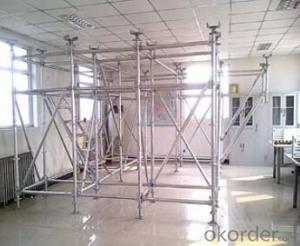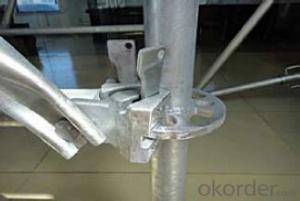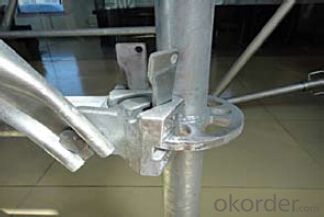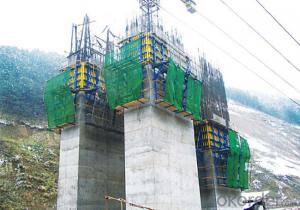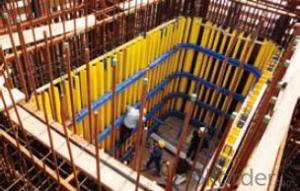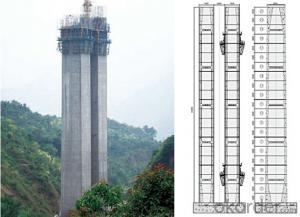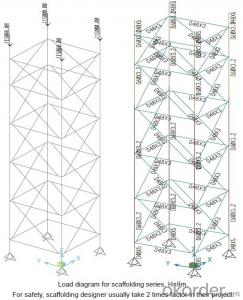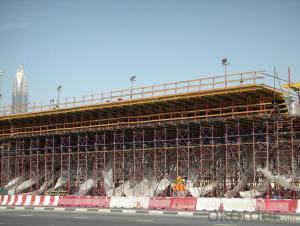Ring-lock Scaffolding accessories for Formwork and Scaffolding System
- Loading Port:
- Tianjin
- Payment Terms:
- TT OR LC
- Min Order Qty:
- 50 m²
- Supply Capability:
- 1000 m²/month
OKorder Service Pledge
Quality Product, Order Online Tracking, Timely Delivery
OKorder Financial Service
Credit Rating, Credit Services, Credit Purchasing
You Might Also Like
Ring-lock Scaffolding
A support system for construction, ownsadvantages of both cup-lock scaffolding andshoring tower.
It is in the development direction of new typescaffolding.
It is widely used in buildings, bridges, tunnels etc..
Characteristics:
◆ Easy to storage and transportation
◆ High degree of standardization
◆ Easy and quick erection
◆ Excellent stability and bearing capacity
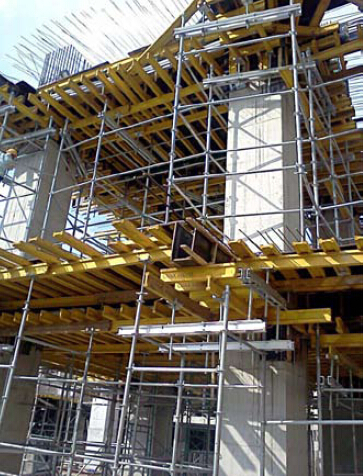
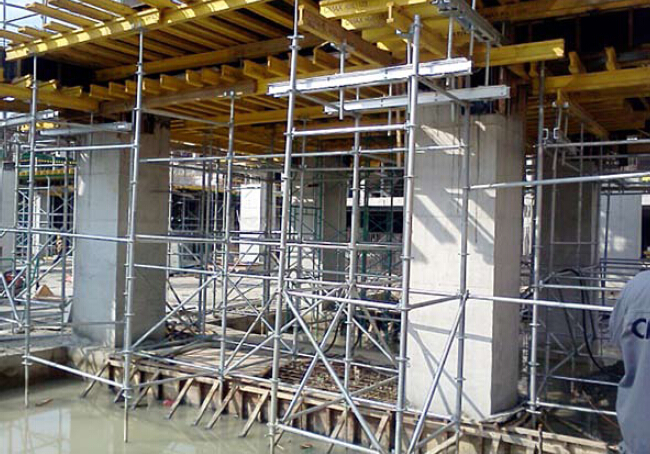
- Q: What are the different types of formwork release agents used with steel formwork?
- Steel formwork can be used with various types of formwork release agents. These agents are applied to the formwork surface before pouring concrete to prevent sticking and ease removal after curing. A commonly used formwork release agent for steel formwork is petroleum-based. It consists of petroleum oils and additives, creating a thin lubricating film on the formwork surface. This film reduces friction between the formwork and concrete, facilitating damage-free formwork removal. Another option for steel formwork is water-based release agent. It contains water, surfactants, and additives, forming a barrier between the formwork and concrete to prevent adhesion. Water-based agents are preferred when environmental concerns or safety considerations make petroleum-based agents less suitable. Apart from petroleum-based and water-based agents, there are specialty formwork release agents available for steel formwork. These agents may be tailored for specific applications or performance requirements. For instance, high-performance release agents are designed to offer superior release in challenging conditions like high temperatures or humidity. Additionally, there are agents specifically formulated for use with certain concrete types, such as self-consolidating or high-strength concrete. Ultimately, selecting the appropriate formwork release agent for steel formwork depends on project requirements, environmental factors, and personal preferences. Careful selection and correct application of the release agent are crucial for successful formwork removal and achieving the desired concrete finish.
- Q: How does steel formwork contribute to the safety of construction workers?
- Steel formwork plays a crucial role in ensuring the safety of construction workers. Its durability and strength provide a stable and secure working platform, reducing the chances of accidents or injuries caused by unstable structures. In addition, steel formwork is fire-resistant, adding an extra layer of protection in case of fire hazards on construction sites. This not only safeguards the workers but also prevents the spread of fire to nearby structures. Moreover, steel formwork is often prefabricated and can be easily assembled and disassembled. This saves time for workers and minimizes their exposure to potential hazards. The ease of assembly also guarantees proper installation, eliminating the risk of weak or faulty structures that could endanger the workers. Furthermore, steel formwork is equipped with safety features like handrails, guardrails, and non-slip surfaces. These features provide additional protection, preventing falls and accidents when working at heights or on elevated platforms. Lastly, steel formwork is designed to withstand external forces such as wind, earthquakes, and heavy loads. This makes it more resistant to structural failures, reducing the risk of accidents and injuries caused by collapses. Overall, steel formwork greatly enhances the safety of construction workers by offering stability, fire resistance, ease of assembly, safety features, and resilience to external forces. These features ensure that workers can carry out their tasks in a secure environment, minimizing the risks associated with construction activities.
- Q: What are the main components of a steel formwork system?
- The main components of a steel formwork system are the steel panels, walers, stiffeners, and connectors. 1. Steel Panels: These are the primary components of a steel formwork system. They are typically made of high-quality steel and come in various sizes and shapes. Steel panels provide the necessary strength and rigidity to hold the concrete in place during the construction process. They are designed to be easily assembled and disassembled, allowing for efficient use on different construction projects. 2. Walers: Walers are horizontal beams or rods that are used to connect and brace the steel panels. They help distribute the load of the concrete and provide additional strength to the formwork system. Walers are usually made of steel or timber and are placed along the edges of the formwork to maintain its shape and prevent any deformation. 3. Stiffeners: Stiffeners are vertical or diagonal members that are added to the steel formwork system to increase its stability and resistance to lateral forces. They are typically made of steel and are placed at regular intervals to provide additional support and prevent any buckling or twisting of the formwork system. Stiffeners are essential for ensuring the safety and integrity of the formwork during the pouring and curing of the concrete. 4. Connectors: Connectors are used to securely fasten the steel panels and other components of the formwork system. They can include various types of bolts, nuts, clamps, or pins. Connectors play a crucial role in maintaining the alignment and stability of the formwork, ensuring that it can withstand the pressure exerted by the wet concrete. They are designed to be easily adjustable and removable, allowing for quick assembly and disassembly of the formwork system. Overall, a steel formwork system is composed of steel panels, walers, stiffeners, and connectors. These components work together to provide the necessary strength, stability, and flexibility required for the construction of concrete structures. The use of steel in the formwork system ensures durability, reusability, and ease of assembly, making it a popular choice in the construction industry.
- Q: Can steel formwork be used for architectural concrete slabs?
- Yes, steel formwork can be used for architectural concrete slabs. Steel formwork offers several advantages in terms of strength, durability, and versatility compared to other types of formwork materials. It provides a rigid structure that can withstand the pressure of fresh concrete, ensuring accurate and precise placement of the slabs. Additionally, steel formwork can be easily reused multiple times, making it cost-effective and environmentally friendly. Its smooth surface also results in a high-quality finish for architectural concrete slabs. However, it is essential to ensure proper insulation and release agents are used to prevent the steel from transferring heat or causing concrete adherence issues. Overall, steel formwork is a reliable and efficient choice for creating architectural concrete slabs.
- Q: How does steel formwork affect the overall aesthetics of a structure?
- Steel formwork can have a significant impact on the overall aesthetics of a structure. Unlike traditional wooden formwork, steel formwork provides a smooth and sleek finish to the concrete, resulting in a more visually appealing appearance. The use of steel formwork allows for precise and accurate shaping of the concrete, ensuring that the structure has clean lines and smooth surfaces. Furthermore, steel formwork enables architects and designers to create complex and intricate designs that would be difficult to achieve with other types of formwork. The strength and durability of steel formwork allow for the creation of unique shapes and patterns, enhancing the artistic value of the structure. In addition to its aesthetic benefits, steel formwork also offers practical advantages. It is reusable, making it a cost-effective option in the long run. The ability to reuse steel formwork reduces waste and promotes sustainable construction practices. Moreover, the durability of steel formwork ensures that the structure maintains its aesthetic appeal for years to come, as it is less prone to wear and tear compared to other formwork materials. Overall, steel formwork plays a crucial role in enhancing the overall aesthetics of a structure. It provides a smooth and clean finish, allows for intricate designs, and offers long-lasting durability. Architects and designers can rely on steel formwork to achieve their desired visual impact while ensuring structural integrity.
- Q: What are the different types of formwork spacers used in steel formwork?
- Various types of formwork spacers are commonly utilized in steel formwork. These spacers play a crucial role in maintaining the desired spacing between the formwork and reinforcement, thus ensuring the structural integrity of the concrete structure. Here, we present a range of formwork spacers frequently employed in steel formwork: 1. Plastic Spacers: Due to their lightweight nature, durability, and easy installation, plastic spacers are extensively employed in steel formwork. They are typically crafted from top-notch plastic materials and come in diverse shapes and sizes to accommodate different reinforcement requirements. 2. Steel Spacers: Steel spacers are another prevalent type of formwork spacer used in steel formwork applications. Constructed from high-strength steel, they possess the capacity to withstand heavier loads. Steel spacers prove ideal for heavy-duty applications that necessitate added strength and durability. 3. Rubber Spacers: In steel formwork, rubber spacers are employed to provide a cushioning effect and prevent direct contact between the reinforcement and the formwork. These spacers are suitable for scenarios where vibration or movement is anticipated, as they efficiently absorb shocks and minimize the risk of damage. 4. Concrete Spacers: Concrete spacers primarily find utility in precast concrete applications. Comprised of concrete, they act as support structures, ensuring the correct spacing between the formwork and reinforcement is maintained. Concrete spacers are not only durable and easy to install but also offer exceptional stability during the casting process. 5. Combination Spacers: Combination spacers are versatile in nature, incorporating various materials such as plastic and steel to provide enhanced strength and stability. These spacers are designed to meet specific project requirements and offer a cost-effective solution for various steel formwork applications. To guarantee optimal performance and safety, it is imperative to select the appropriate formwork spacer type based on the project's specific requirements, encompassing load capacity, spacing needs, and environmental conditions. Seeking guidance from a structural engineer or construction professional can ensure the correct selection and installation of formwork spacers.
- Q: How does steel formwork contribute to the overall durability of a structure?
- Steel formwork contributes to the overall durability of a structure by providing a strong and rigid framework during the concrete pouring process. It ensures accurate and precise shaping of the concrete, resulting in a solid and uniform structure. Steel formwork is highly resistant to warping, bending, and cracking, making it more durable than other types of formwork materials. Its strength and durability allow for multiple reuse, reducing construction costs and minimizing waste. Additionally, steel formwork provides excellent support for the concrete as it cures, preventing any deformation or collapse. Overall, steel formwork plays a crucial role in enhancing the longevity and robustness of a structure.
- Q: What are the different types of formwork anchors used in steel formwork?
- There are several types of formwork anchors that are commonly used in steel formwork. These anchors are essential for securing the formwork to the structure and ensuring the stability and safety of the construction process. Some of the different types of formwork anchors used in steel formwork include: 1. Wedge Anchor: This type of anchor consists of a threaded rod with a wedge-shaped end. It is inserted into a pre-drilled hole in the concrete structure and secured by tightening a nut on the threaded end. The wedge anchor provides a strong grip and is commonly used for securing formwork to concrete walls or slabs. 2. Screw Anchor: Screw anchors, also known as self-tapping anchors, are designed for use in softer materials such as wood or light-gauge steel. They have a threaded body that is screwed into the material, providing a secure connection for the formwork. Screw anchors are easy to install and remove, making them a popular choice for temporary formwork applications. 3. Hook Anchor: This type of anchor is shaped like a hook and is typically embedded into the concrete structure during the pouring process. The formwork is then attached to the hook using bolts or other fasteners. Hook anchors provide a strong and reliable connection and are commonly used in applications where high loads or lateral forces are expected. 4. Swift Lift Anchor: Swift lift anchors are specifically designed for lifting and handling precast concrete elements, including steel formwork. These anchors are embedded into the structure during the pouring process and provide a safe and efficient method for lifting and positioning the formwork. 5. Plate Anchor: Plate anchors consist of a flat plate with holes for bolts or other fasteners. They are commonly used in steel formwork systems to secure the formwork to the structure. Plate anchors are versatile and can be easily adjusted or relocated as needed. 6. Chemical Anchor: Chemical anchors are used when a strong and permanent connection is required. These anchors consist of a resin or adhesive that is injected into a pre-drilled hole in the concrete structure. The steel formwork is then attached to the chemical anchor, creating a secure bond. Each type of formwork anchor has its own unique advantages and is suitable for different applications. The choice of anchor will depend on factors such as the type of structure, the load requirements, and the duration of use. It is important to select the appropriate anchor and ensure proper installation to ensure the safety and stability of the formwork system.
- Q: What are the typical corrosion protection measures for steel formwork systems?
- There are several typical corrosion protection measures for steel formwork systems that can help extend their lifespan and maintain their structural integrity. One common method is the application of protective coatings. This can include the use of epoxy coatings, which provide a barrier against moisture and corrosive elements. These coatings are typically applied to the entire surface of the steel formwork system, including any joints or connection points. The coating acts as a protective layer, preventing direct contact between the steel and the surrounding environment. Another measure is the use of galvanizing. Galvanizing involves coating the steel formwork system with a layer of zinc. This process creates a protective barrier that helps prevent corrosion. Galvanizing is particularly effective in environments with high levels of moisture or exposure to saltwater, such as coastal areas. Regular maintenance is also essential for corrosion protection. This includes inspecting the formwork system for any signs of damage or deterioration, such as rust or pitting. Any areas of concern should be addressed promptly, either through repair or replacement. Additionally, regular cleaning and removal of any debris or contaminants can help prevent corrosion from occurring. Proper storage and handling of the steel formwork system is another important measure. The formwork should be stored in a dry, well-ventilated area to minimize exposure to moisture. It should also be handled correctly to avoid any unnecessary damage or scratches, which can compromise the protective coatings. Lastly, the use of sacrificial anodes can be employed as a corrosion protection measure. Sacrificial anodes are made from a metal that is more reactive than the steel formwork system, such as zinc or magnesium. When attached to the formwork, the sacrificial anode corrodes instead of the steel, effectively sacrificing itself to protect the system. Overall, a combination of protective coatings, galvanizing, regular maintenance, proper storage, and sacrificial anodes can provide effective corrosion protection for steel formwork systems, ensuring their longevity and durability.
- Q: I would like to ask you 60 models of building steel formwork, steel mold fixed method and fixed plate type fixed hole number
- P6015:600 * 1500mm, P6012:600 * 1200mm, P6009:600 * 900mm, construction templates generally use U card or bolt fixation
Send your message to us
Ring-lock Scaffolding accessories for Formwork and Scaffolding System
- Loading Port:
- Tianjin
- Payment Terms:
- TT OR LC
- Min Order Qty:
- 50 m²
- Supply Capability:
- 1000 m²/month
OKorder Service Pledge
Quality Product, Order Online Tracking, Timely Delivery
OKorder Financial Service
Credit Rating, Credit Services, Credit Purchasing
Similar products
Hot products
Hot Searches
Related keywords
